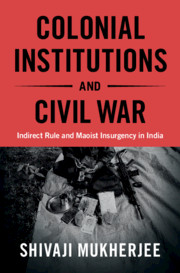Book contents
- Colonial Institutions and Civil War
- Cambridge Studies in Contentious Politics
- Colonial Institutions and Civil War
- Copyright page
- Contents
- Figures
- Tables
- Acknowledgments
- Part I Theory
- 1 Colonial Institutions and Civil War
- 2 Legacies of Colonial Indirect Rule: Weak State, Ethnic Inequality, and Insurgency
- 3 Varieties of Indirect Rule and Causal Pathways to Maoist Insurgency in India
- Part II Qualitative and Quantitative Testing
- Part III Generalizability
- Bibliography
- Index
- Series page
3 - Varieties of Indirect Rule and Causal Pathways to Maoist Insurgency in India
from Part I - Theory
Published online by Cambridge University Press: 15 May 2021
- Colonial Institutions and Civil War
- Cambridge Studies in Contentious Politics
- Colonial Institutions and Civil War
- Copyright page
- Contents
- Figures
- Tables
- Acknowledgments
- Part I Theory
- 1 Colonial Institutions and Civil War
- 2 Legacies of Colonial Indirect Rule: Weak State, Ethnic Inequality, and Insurgency
- 3 Varieties of Indirect Rule and Causal Pathways to Maoist Insurgency in India
- Part II Qualitative and Quantitative Testing
- Part III Generalizability
- Bibliography
- Index
- Series page
Summary
This chapter applies the theory to India. I first describe the colonial history of how the British annexed certain Indian states into direct rule and signed treaties with other Indian princes as indirect rule. I then develop a theory of different types of indirect rule within India—a formal type of indirect rule through princely states and an informal type of indirect rule through zamindars/landlords. These different types of colonial indirect rule created different causal pathways of structural inequalities and low state capacity, which persisted through path dependent mechanisms into the postcolonial period to result in Maoist insurgency in the 1980s. The zamindari landlord tenure system created one causal pathway of land/caste inequality and lower bureaucratic penetration in the northern epicenter of insurgency in Bihar/Bengal, while the princely states in central-eastern India created a second causal pathway of exploitation of land and natural resources in tribal areas in Andhra Pradesh and Chhattisgarh. I also theorize the role of rebel agency in the form of Maoist leaders and organizations and analyze how the interaction of rebel agency with the structural conditions created by indirect rule creates conjunctural causation for Maoist insurgency.
Keywords
- Type
- Chapter
- Information
- Colonial Institutions and Civil WarIndirect Rule and Maoist Insurgency in India, pp. 56 - 84Publisher: Cambridge University PressPrint publication year: 2021



